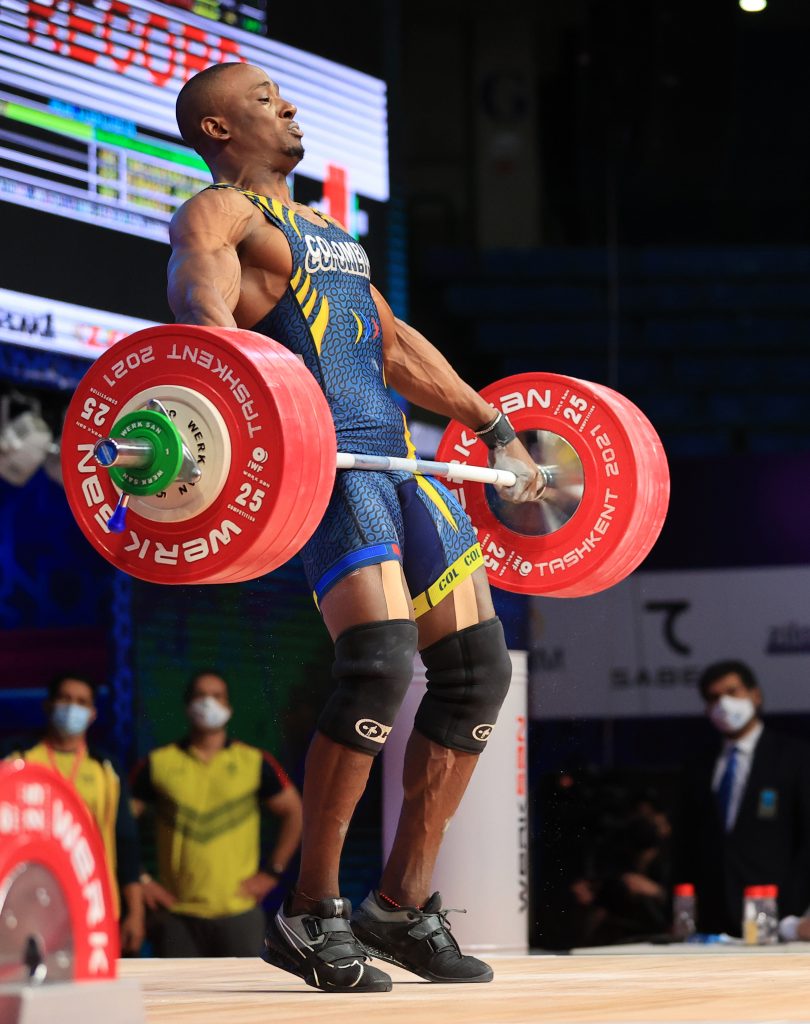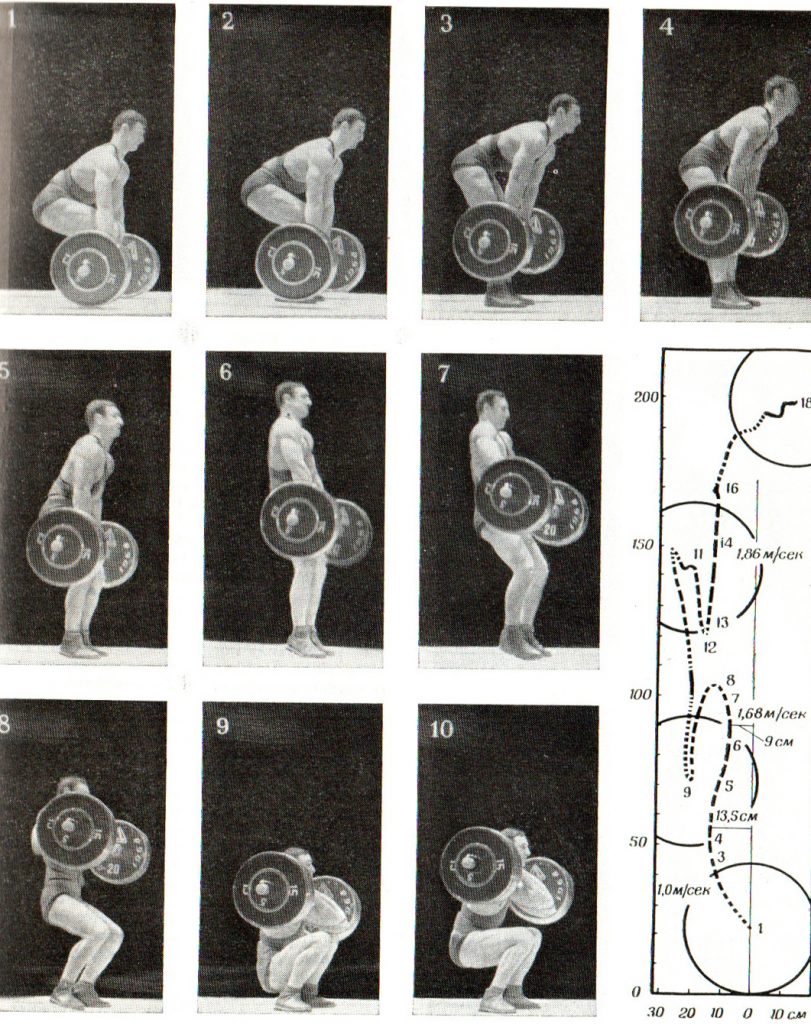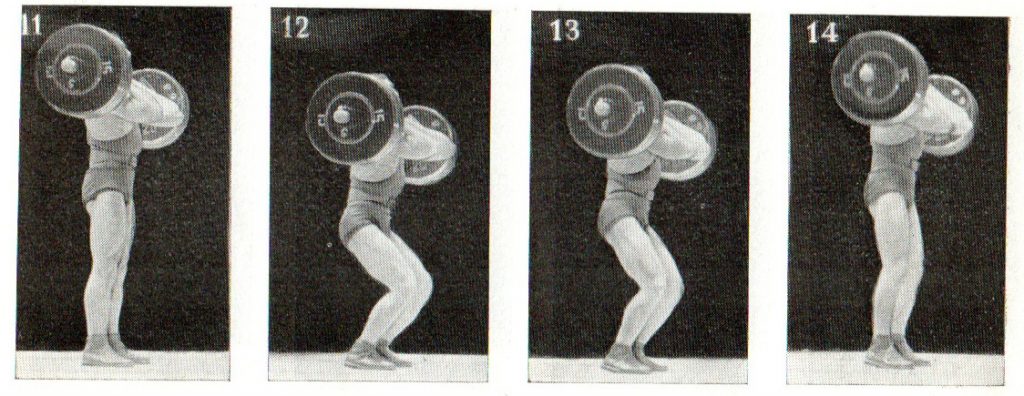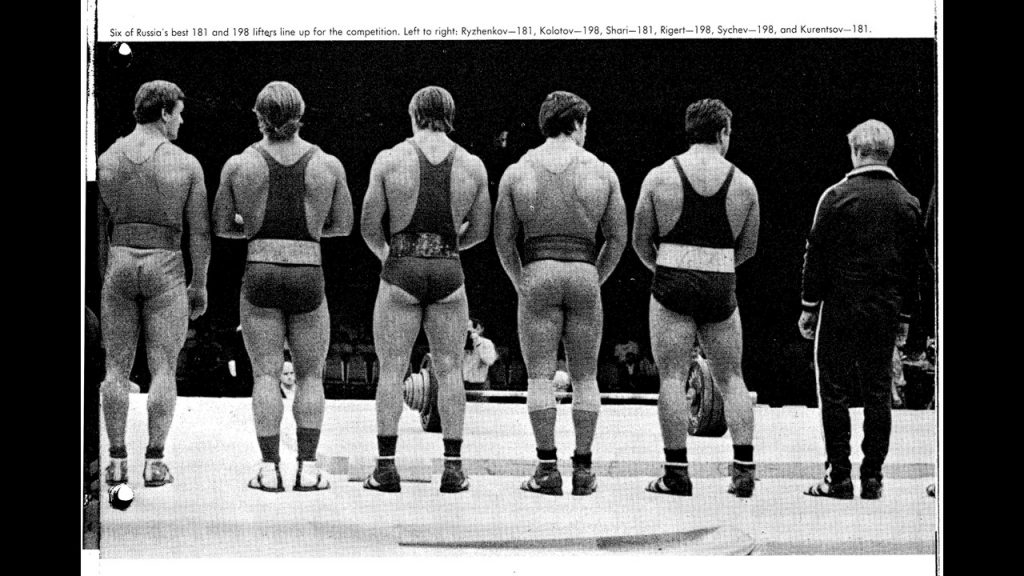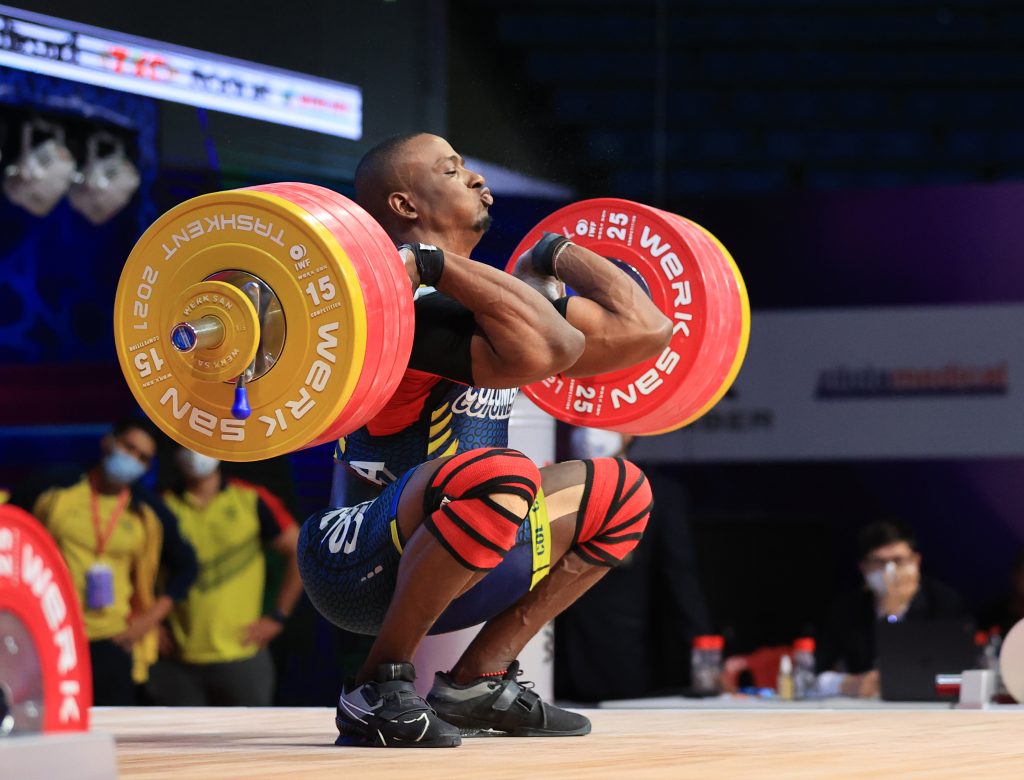Andrew Charniga
www.sportivnypress.com
Tall – for – weightlifting – weightlifters dismissed when ‘math discovers science’
“… a limit on the numbers of cells in parallel would not restrict height in the unlimited-class champions, but any disadvantage of taller height, such as having to lift the weights a greater distance, would restrict the height of these champions to the minimum necessary to achieve the upper limit of cell number.” Ford, et al, 2001
In point of fact, other guys like those three Polish champions of the late 1960s and 1970s would gradually appear on the international scene; but, they tended to be dismissed as anomalies; not part of a trend in an ongoing evolution of weightlifting sport.
For instance, an analysis (Tumanyan, 1976) of the heights of gold medalists from the 1964, 1968 & 1972 Olympics made mention of some guys who were taller than established norms for optimum height. These athletes were Zdrazila (CZE) and Bikov (BUL), both 75 kg class; Nikolov (BUL) in the 90 kgs from 1972; and, in the +110 Zhabotinsky & Alexeyev (USSR). They were the only champions from three Olympics who exceeded the established norms of optimum height to weight class. The taller than optimum heights of the +110 champions was due, as reasoned by Vorobeyev, to their heavier bodyweight; which means they would typically be taller.
Math Is Not Science
Tumanyan’s (1976) reference for the heights of Olympic champions was cited from the research of Shanenkov (1975) who stipulated:
“Olympic champions in weightlifting are characteristically shorter than the average height of their competitors, i.e., there is an inverse relationship between the weightlifter’s height and their results.” (Y.M. Shanenkov, 1975).
Shanenkov (1975) compared the height of the Olympic champions from 1964; 1968 and 1972 to the mean of the medalists and the mean of each weight class. He dismissed the five (5) athletes who were taller; because the math had already confirmed what the lifting community already believed: shorter weightlifters have the advantage and are most likely to be champions:
Figure 1. A tall – for – weightlifting – weightlifter Paredes, Lesman (COL) {96 kg/190 cm = 505 {545} gold medalist of the 96 kg class snatching a world record 187 kg @ 2021 world championships. Charniga photo.
Shanenkov (1975) dismissed Zdrazila and company out of hand (the five taller gold medalists), as outliers. The author was able to validate his work as ‘fact’ because his ‘math discovered the science’ of shorter weightlifting champions:
“The differences were statistically not significant and do not constitute a trend.” Shanenkov (1975)
However, there were some factual errors in his calculations: a very lean, with long limbs H. Zdrazila was 171.3 cm not 169 cm in height, as reported. Furthermore, Shanenkov failed to follow up the mathematics to ascertain if in fact taller weightlifters were merely outliers; or, potentially indicative of a trend.
“If all the middleweights were to stand in a line and a stranger was asked to pick the winner, he certainly would not pick the slender, coughing Zdrazila.” Bob Hoffman 1965, {commenting in his report in Strength & health magazine on the results of the 1964 Olympic weightlifting competition of the 75 kg class}
That being said, the obvious, but not considered, question: outliers or no, how did the tall, lean guys lift big weights if they have less muscle per centimeter of height? The issue of lower Bio – density is coupled with the physics related to height; what with taller guys having to perform more work against gravity; in comparison with the shorter lifters whom are within the optimum height weight ranges. That is to say, the math in the literature implies a minimum composition of muscle mass per centimeter of height, i.e., better yet, an optimum Bio – density is necessary to raise record weights.
For instance, Shanenkov failed to mention the 82.5 kg class bronze medalist of the 1968 Olympics. N. Ozimek (Pol), who was 178 cm in height. Ozimek who went on to win silver in 1972; was the 1965 world champion at 82.5 kg. At 178 cm in height, he was 6 cm taller than the 1964 gold medalist of the 82.5 kg class; 8 cm taller than the 1968 gold medalist and 7 cm taller than the 1972 gold medalist. Built along the same lines as Zdrazila, with seemingly not enough muscle mass per centimeter of height; this circumstance should have aroused interest as to how do guys like Zdrazila and Ozimek compete with the shorter, stockier, more muscular lifters whose statures were purported to be better suited for weightlifting?
No doubt there was a plethora on the international scene of the ‘normal for weightlifting’ short, stocky weightlifters. These guys would adhere the correct technique rules of the day: by keeping their feet flat in the classic exercises, for instance; as indicated in part 2. This circumstance unquestionably affected Roman’s analysis and judgement of Olympic champion Zdazila’s technical errors.
As he did with Zdrazila, Roman (1968) found numerous faults with world champion and world record holder N. Ozimek’s technique. Both Zdrazila and Ozimek shifted knees under bar with heels raised and arms bent in the pull; which then straightened as the explosion phase was completed. Both are considered serious errors. Ozimek even jumped 11 cm backwards to squat under the barbell. Even:
…”the legs {of Ozimek, POL} have straightened faster than the trunk” R.A. Roman, 1968
Figure 2. World champion, world record holder and Olympic medalist N. Ozimek (POL) lifting with heels raised, bent arms and even bowing of knees together in recovery from the squat. From R.A. Roman’s The press, the snatch, the clean and jerk FIS, Moscow, 1968
Furthermore, the ‘technically challenged’ world champion even performed the half squat for the jerk wrong; bending to a knee angle of 95° when the optimum is 100- 120°; on the balls of his feet, no less:
“The athlete (N. Ozimek (POL) performs a deep half squat and leans forward in the jerk; which in turn, causes the barbell to shift significantly away from the athlete; of course these are errors. “…the thrusting phase of the jerk is executed with the athlete standing on the balls of his feet; the barbell does not rise strictly vertical …”, R.A. Roman, 1968
Figure 3. N. Ozimek (POL) bending outside the optimal parameters for the jerk with heels raised in third photo from left. From R.A. Roman’s The press, the snatch, the clean and jerk FIS, Moscow, 1968
However, that being said, scientists are people too; a bias against tall weightlifters; an assumption of lower potential in weightlifting attributed to height, can cloud one’s objectivity. By way of contrast, from the vantage point of a wealth of experience; USA Olympic coach Bob Hoffman, noted Ozimek’s height; nonetheless, gushed over his athleticism:
“Ozimek is tall for his class and is one of most splendid physical specimens I have ever seen in all my years of athletics. He is lean but tremendously muscled, having the most outstanding shoulder development I have ever seen.” Bob Hoffman, US Olympic coach, editor Strength & Health
Curiously enough, of the nineteen (19) world and Olympic champions whose jerk technique Roman analyzed in his book The press, the snatch, the clean and jerk; only Talts (90 kg, USSR) had a higher velocity of barbell separation from the chest than Ozimek: 1.91 m/sec versus Ozimek’s technically incongruous 1.86 m/sec. Later on Roman observed barbell velocities at separation were higher during the press era; presumably because of stronger arms and shoulder girdle muscles. Ozimek’s bar separation speed was one of the highest ever recorded; despite the fact he jerked with elbows raised high; a poor disposition from which to realize the strength of the pressing muscles (see figure 3).
Yet, there was no attempt to analyze how or why a guy too tall for weightlifting could lift weights typically reserved for the short and stocky.
Nevertheless, the ‘facts in figures’ fixation of the mathematically verified world of science was obvious from Shanenkov’s explanation of A. Nikolov (BUL) who won 90 kg gold in 1972. He was the tallest of the Olympic champions (excluding the superheavyweights); an outlier at 182 cm in height. Nikolov was even 8 cm taller than J. Talts (USSR) the 1972 gold medalist at 110 kgs. Shanenkov observed that if Nikolov continued to train in weightlifting; out of necessity; he would be forced to move up a weight class; because, he (Nikolov) would be gaining weight from increased muscle mass.
Even that assessment was in error. The 182 cm Nikolov continued to compete as a 90 kg; placing 2nd in 1973 European championships. He went on to set world records in the snatch; defeating David Rigert (90 kg/175 cm) in the snatch on his way to winning the silver medal at the 1974 European weightlifting championships; while equaling Rigert’s total of 385 kg.
The Soviet system of selection and training in weightlifting fostered increasing muscle mass over time from beginning ages of 12 – 22; such that scales of optimum weight to height ratios could be used to rate athletes by Bio – density; or, in effect, an implied specific gravity; which is a measure of the relative content of dense tissues of muscle and bone to less dense and useless fat tissue.
Data compiled by Dvorkin (1992) could be used to evaluate the effectiveness of the athlete’s progress by the weight/height development over time; from the onset of training to early adulthood.
For instance, some of Dvorkin’s data rating young 82.5 kg weightlifters:
82.5 kg excellent: >488; good – 470 – 488; satisfactory- <470 18 – 19 year olds
82.5 kg excellent: >463; good – 455 – 463; satisfactory- <455 16 – 18 year olds
Compare the bio – density figures of Dvorkin to that of N. Ozimek @463; who competed in the press era no less. His weight to height ratio, which would rate at best, good for a 16 – 18 year old; only satisfactory for 18 – 19 year old and, significantly lower than the 488 excellent rating of an 18 – 19 year old. By the Soviet measure, Ozimek at 178 cm in height would simply not have enough muscle to bone to fat to be on track to reach high results in weightlifting at the 18 – 19 year old stage of his development. Ozimek’s Bio – density of 463 would conform to a height of under 171 cm; consistent with the Soviet models of shorter weightlifting champions.
This is further evidence Soviet sport science tied increases in results in the classic exercises to rising muscle mass; crammed into specific frames, over time, which would conform to a presumed optimum density of contractile tissue for a given weight category.
Consequently, once a bias, such as weightlifting champions are short; becomes ingrained in a collective conscious; all the more so because mathematics has helped confirm it: “A negative correlation is observed: within a given weight class, the higher the sportsman’s qualification the shorter his height.” Oleshko, V. 1982; it is very difficult to dislodge it.
The math discovers science devotees would rather dismiss the outliers as anomalies so as not to discredit their ‘math discovers science’. Consequently, there is no telling how many too – tall – for – weightlifting – weightlifters could have competed at the international level over the years; were it not for their being dismissed for selection; because, the persistent belief their height precluded a successful career in weightlifting.
That being said; in a follow – up research to his analysis of the heights of gold medalists of the 1964 – 1972 in Shanenkov performed the same math on the 1976 Olympians.
He made the following observations:
/ there was a tendency for slightly taller champions in six of the weight classes;
/ there was a tendency for younger lifters; for instance, Bulgaria had the youngest team, with a mean age of 23.3 years; winning six gold medals.
/ the heights of the champions were within the averages for the class; indicating coaches were actively recruiting athletes who fit the presumed optimum height specifications for each weight class.
Figure 4. A not so subtle hint the role height played in the selection process for weightlifting is the obvious near uniformity in the height of elite lifters within a given weight class range. Soviet champions introduced for the 1972 Baltic Cup from left to right: Ryzhenkov (82.5 kg); Kolotov (90 kg); Shary (82.5 kg); Rigert (90 kg); Sychev (90kg); Kurentsov (75 kg). Kono Photo
Shanenkov’s observations of taller – younger Olympic champions was not interpreted as a harbinger of a trend evolving in weightlifting sport. Such an evolution would in fact usher in an influx of younger athletes who would not have the time to accumulate enough muscle to fulfill the Bio – density stipulations of the past. Relatively less muscle mass density would not hinder the results of youthful athletes. Instead the youthful athlete’s easier acquisition of requisite skills to move the body efficiently in the classic exercises with great speed; would more than substitute for big muscles.
Weightlifting strength cannot be blind
The academia/textbook fixation with muscle mass, fiber types, arrangement of filaments and so forth; as principle determinants of results in the speed sport of weightlifting; for all intent and purpose, are based on another underlying assumption; the expression of strength in weightlifting is ‘blind’. That is to say, the strength/power of the academic world precludes inter – muscular coordination, i.e., the ‘skill of strength’, in dynamic sport as the main factor; which of course precludes the critical role of an athlete’s bio – spring system. Hence, the ignorance of academics; a knowledge centered around a ‘blindness of strength’, a static quality; although no longer relevant in modern weightlifting; nonetheless persists:
“…the shorter height and limb lengths of weightlifters provide mechanical advantages when lifting heavy loads by reducing the mechanical torque and the vertical distance that the barbell must be displaced. Furthermore, the shorter body dimensions coincide with a greater mean skeletal muscle cross-sectional area that is advantageous to weightlifting performance.” Story, A., Smith, H. 2012
Figure 5. A tall – for – weightlifting world champion weightlifter and record holder lifting with presumed disadvantages of longer limb lengths (especially lower extremities) requiring more mechanical torque and longer distances to lift the barbell. Charniga photo.
Many western authors (Ford, et al, and others) would be hard pressed to understand 50 – year old Soviet research; based on real world experiences:
“…the achievements of distinguished masters of the barbell V. Kurentsov, A. Vakhonin, Y. Katsura, V. Belyaev, and others, who as we have said, utilized less than 40% of their strength potential.” I.P. Zhekov, 1969. Translated by Andrew Charniga.
Consequently, a ‘math discovers science’ devotee espouses a simple quantification to encapsulate the strength of weightlifters:
“…the weight lifted depends on the number of myofilaments arranged in parallel.” Ford, et al, 2000
Presented in table 1 are Bio – density ratings of eight (8) top class lifters from 90 – 100 kg classes. The bio – density of four; including those with the highest rating of 1.26: Vlad and Paredes; had less mass per centimeter of height than the USSR models of 1988, i.e., they performed more work against gravity relative to the height of the barbell at the start, had mechanically inferior ‘long limbs’, and so forth.
The two lowest rated athletes (1.35 & 1.36) had the highest Bio-density with the advantage of shorter relative distances to raise the barbell (less work against gravity); and, presumably the most muscle mass to accomplish the task of lifting. The Bio – density of weight/height of these two elite lifters conforms to weight to height models of the past.
Table 1. Bio – density rating of some Olympic and world weightlifting champions 90 – 100 kg.
|
Athl |
Nat. |
cl./kg |
Ht./cm |
Biod |
Sn |
C&J |
Tot |
USSR |
%ht |
|
Vlad |
ROM |
100 |
181 |
552 |
2.75 |
2.32 |
1.26 |
564 |
11,7% |
|
Paredes |
COL |
96 |
190 |
505 |
2.70 |
2.37 |
1.26 |
545 |
11.1% |
|
Kolecki |
POL |
94 |
185 |
508 |
2.78 |
2.18 |
1.29 |
540 |
11.4% |
|
Blagoyev |
BUL |
90 |
169 |
532 |
2.72 |
2.39 |
1.28 |
510 |
12.5% |
|
Ilyn |
KAZ |
94 |
174 |
540 |
2.92 |
2.32 |
1.29 |
533 |
12.1% |
|
Nikolov |
BUL |
90 |
182 |
494 |
2.82 |
2.35 |
1.28 |
510 |
11.6% |
|
Moradi |
IRI |
96 |
171 |
561 |
2.97 |
2.41 |
1.35 |
545 |
12.3% |
|
TIAN |
CHN |
96 |
172 |
558 |
3.08 |
2.42 |
1.36 |
545 |
12.2% |
IK – Index of Kettle weight in grams/height in cm; Bio-density index: IK/snatch, jerk and total. USSR: Optimum index of kettle according to Vorobeyev’s (1988) table of optimum height to weight class. % ht: height of the bar from the floor as a percentage of the athlete’s height.
Evidence such as the data in the table 1 indicates an influx of tall – for – weightlifting- weightlifters is not anomalous and should raise interesting questions for further study; such as, just how much muscle mass actually contributes to high results in the modern era of weightlifting. At the very least, such pronouncements a weightlifter’s limitations are dictated by the number of muscle filaments, i.e., a science discovered by numbers; are false.
References
/ Charniga, A., “Bio – density rating of tall – for – weightlifting – weightlifters” Parts I & II. www.sportivnypress.com
/ Storey, a., Smith, H., “Unique aspects of competitive weightlifting: performance, training and physiology”, Sports Med 2012 Sep 1:42(9):769-90doi: 10.1007/BF03262294.
/ Shanenkov, Y.M., “A Comparative Analysis of the Height – Weight Indices of Weightlifters at the XX and XXI Olympic Games” Tiiazhelaya Atletika. FIS, Moscow, 1978:29-31. Translated by Andrew Charniga.
/ Ford, L.E., Detterline, A. J., Ho, K.K., CAO W., “Gender- and height-related limits of muscle strength in world weightlifting champions”, PMID: 10956351, DOI:10.1152/jappl.2000.89.3.1061
/ Tumanyan, G.S., Martirosov, A.G., Body Structure and Sport FiS, Moscow, 1976 Pp180 – 196. Translated by Andrew Charniga
/ Roman, R.A., The Press, the Snatch, the Clean and jerk, FIS, Moscow, 1968. Translated by Andrew Charniga.
/ Hoffman, B. “Competition report of the 1964 Olympics”, Strength & Health, February, 1965
/ Medvedyev, A.S., Lukashev, A.A., “The Clean and jerk Technique of World Record Holders V. Alexeyev and G. Bonk”, Tiiazhelaya Atletika Ezhegodnik, 1977. Translated by Andrew Charniga.

